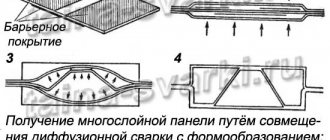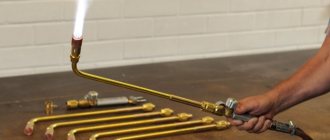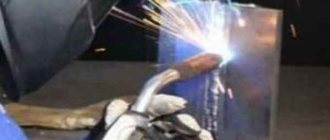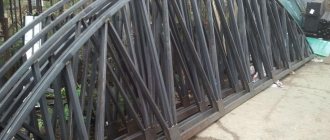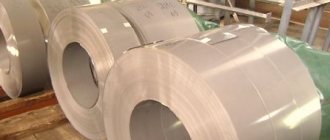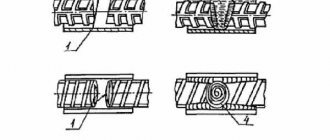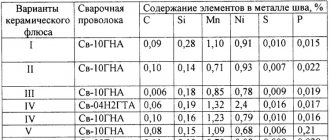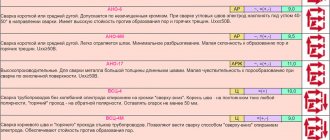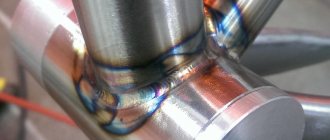It is not always possible to produce solid structures, and the use of massive workpieces is impractical due to the generation of a large amount of waste. In this case, fusion welding is used. The method is suitable for processing any materials that change their state when heated. In some cases, thermite welding is used.
Fusion welding is used in cases where it is not always possible to produce solid structures.
The essence of the process
The principle of operation is to use a powerful energy source that transfers heat to the weld pool. Molten wire is fed into the working area, which when cooled forms a weld. By moving the torch, the treated area is increased, and filler material is added at the same time. As the melt cools, it crystallizes, forming a strong compound. The process of exciting an electric arc occurs in 3 stages:
- the electrode touches the workpiece, a short circuit occurs, heating the tip;
- the rod is retracted to the required distance, which is determined experimentally;
- maintain stable arc burning.
Some devices are equipped with a contactless ignition function. For this purpose, a special device is used - an oscillator.
Electric arc welding of metal
Electric arc welding of metal is one of the methods of welding metals, the essence of which is to heat and melt the metal with an electric arc. This is one of the most common welding methods. This method was first discovered by the scientist N.G. Slavyanov. in 1888. To do this, he used a metal consumable electrode. Welding took place under a layer of flux. Electric arc welding of metal is carried out using direct current. In this case, the plus is on the part being welded, and the minus is on the electrode. The electric welding process is performed with both a consumable electrode and a non-consumable one. This welding method is widely used in repair work, installation, mechanical engineering, construction and other areas.
Areas of application
The method is widely used in construction. It is used for reliable connection of metal elements: sheets, profile and standard pipes. However, the scope of application is not limited to construction. The technology is widespread in automobile and aircraft manufacturing, and other branches of science and technology.
Aircraft manufacturing is one of the industries where fusion welding is used.
Classification of the main types of fusion welding
Depending on the method of heat transfer, methods are divided into gas and electric. The latter technology, in turn, has several varieties.
Recommended reading: How to use ultrasonic welding
Plasma
A shortened arc is used for heating. The carrier of energy is an electrical discharge. The metal heats up due to the action of the ionizing gas. To start the process, an increase in temperature to +5500 °C is required. The operating principle of the method is based on the melting of the material by a plasma flow generated by a plasma torch. The arc is surrounded by gas, which quickly ionizes. Charged particles form a directed flow. The method is used for welding workpieces from:
- tungsten;
- molybdenum;
- nickel alloys;
- stainless steels.
Plasma welding can be used to join and cut metal sheets up to 1 cm thick.
Plasma welding.
Gas
Welding with smooth heating is used for fastening copper, aluminum, cast iron, and steel workpieces. The distance between the parts to be joined is filled with filler material, which melts along with the edges of the structural elements. The joint is heated with a burner, the flame in which is formed when a mixture of oxygen and another gas is ignited:
- hydrogen;
- propane;
- butane;
- acetylene;
- gasoline or kerosene vapors.
Gas welding.
Gas welding does not use electrical energy, so work can be performed in any conditions. The disadvantage is the inability to fasten thick parts.
Dugovaya
The metal is heated by an arc that occurs when current passes through the parts and the electrode. A weld pool is formed from the molten edges of the workpieces and filler material. After the liquid metal cools, a weld is formed. Arc welding methods are classified according to the following characteristics:
- type of electrode (non-consumable, consumable);
- type of current (direct, alternating, with direct or reverse polarity);
- level of mechanization (automatic, manual, semi-automatic);
- type of arc (direct or indirect);
- method of protecting the working area (fluxes, use of coated electrodes or inert gas).
The filler material must be made of the same metal as the workpiece. If it is impossible to determine the steel grade, transition electrodes are purchased. They are also used for welding parts made of dissimilar steels. Carbon, tungsten or graphite rods are used as non-consumable electrodes.
Recommended reading: What is TIG welding
Arc welding.
Laser
The edges are heated under the influence of the beam. Laser welding is considered the most precise method of forming complex structures.
To reduce the cost of work in industrial conditions, the laser beam is divided into several parts that heat many joints. In home workshops, compact installations are used that form seams with surface or deep melting.
Laser welding is suitable for working with precious and non-ferrous metals, stainless steel, titanium. The advantages of the method include:
- no heating of areas adjacent to the seam, minimizing the likelihood of deformation;
- ability to work in hard-to-reach places;
- switching the device to cutting mode without using additional modules;
- possibility of working without gaseous medium and flux.
Laser welding.
Disadvantages include low efficiency and high cost of equipment.
Electroslag
To melt the metal, the energy released when current passes through a layer of liquid slag is used. The workpieces are installed vertically, with a short distance.
The wire is fed into the gap through nozzles connected to a power source.
The weld pool is supported by sliders. They move as the seam is formed. Electroslag welding is used to connect dimensional elements made of nickel, copper and titanium alloys. The advantage is the formation of a seam of any thickness in 1 pass.
Electroslag welding.
Induction
The workpiece is heated under the influence of electromagnetic induction. For this purpose, high-frequency currents are used that penetrate the metal. The seam is formed in a few seconds. The heating duration does not depend on the thickness of the workpieces or the thermal conductivity of the material. This welding is most often used to connect elements of steel pipelines.
Induction welding.
Electron beam welding
The source of high temperature is a focused beam produced by a special gun. The process is carried out in a vacuum chamber. Melting is promoted by intense bombardment of the metal by electrons moving at high speed. The kinetic energy of particles upon impact is converted into thermal energy. The metal melts and a seam is formed. The method is widespread in instrument making, aviation, and the space industry.
Electron beam welding.
Equipment for manual arc welding
The equipment required for manual arc welding consists of:
- from a power source, which can be either portable or stationary, depending on the type of work performed by the welder;
- from a cable with an electrical holder in which an electrode coated with a special coating is fixed;
- from a reverse grounding cable to connect the workpiece being welded to the power source.
Also, do not forget about additional equipment, such as: a protective mask, welder’s gloves, various devices for removing slag and other things necessary for the convenience of the specialist.
Fusion welding technologies
The process of joining parts when using any method includes the following steps:
- Preparation of elements. The edges are cleaned of grease and corrosion, and the edges are cut off taking into account the thickness.
- Installing parts in the desired position and fixing them.
- Ignition of the arc (using some methods). In other cases, parts are heated in a different way.
- Seam formation. After cooling, the connection is cleaned of slag.
Recommended Reading: Friction Welding Information
Describe manual consumable arc welding
Manual arc welding is performed with a consumable or non-consumable (carbon, graphite, tungsten, hafnium) electrode. When welding with a consumable electrode (Fig. 5.1), the arc burns between it and the product. The formation of the weld metal is carried out due to the electrode material and the melting of the base metal in the arc zone. When welding with a non-consumable electrode, filler material is supplied from the outside to form the weld metal into the arc zone.
Consumable electrode welding has found the greatest application, since it can be used in all spatial positions, welding ferrous, non-ferrous metals and various alloys. In this case, electrodes with a diameter of 1÷ 12 mm are used. However, the bulk of the work is performed with electrodes with a diameter of 3 ÷ 6 mm.
Electrodes are classified according to the material from which they are made, by purpose, by type of coating, by the properties of the weld metal, by the permissible spatial positions of welding or surfacing, by the type and polarity of the current.
According to their intended purpose, electrodes are divided into the following groups: for welding carbon and low-alloy structural steels - U; for welding heat-resistant alloy steels - T; for welding high-alloy steels with special properties - B; for surfacing layers with special properties - N.
48. Weldability. Basic technological methods for difficult and limited weldable steels .
Limited weldability steels have a carbon content of 0.36 to 0.45% and are prone to cracking. Welding requires mandatory heating. Poorly weldable steels contain carbon in amounts greater than 0.45%. When welding them, special technological processes are required.
Alloying steel with one or more alloying elements gives it certain physical and mechanical properties. As a rule, increasing the level of alloying and strength of steel leads to a deterioration in its weldability, and carbon plays a primary role in this.
Low alloy steels are well welded by all melting methods. Obtaining an equal-strength welded joint during welding, especially with heat-strengthened steels, causes certain difficulties. In zones far from the high-temperature region, cold plastic deformation occurs. When subsequent sutures are applied, these zones become areas of strain aging. This ultimately leads to a decrease in the plastic properties and an increase in the strength properties of the metal and, accordingly, to the appearance of cold cracks. In medium-alloy steels, the susceptibility to hardening increases, and therefore such steels are highly sensitive to the thermal cycle of welding. Their heat-affected zone turns out to be sharply hardened and, therefore, non-plastic under all welding conditions that ensure satisfactory formation of the weld. Therefore, in order to reduce the cooling rate of the heat-affected zone when welding these steels, preheating of the welded product is necessary.
When welding high-alloy chromium 08X13, 08X17T and some other steels, there are distinctive features: a high threshold of cold brittleness of steel, usually located in the positive temperature range; tendency to significant embrittlement in the heat-affected zone; low ductility and toughness of the weld metal made with welding materials of a chemical composition similar to steel; inability to eliminate embrittlement by heat treatment.
Welding of such steels must be performed with minimal heat input, since with an increase in heat input, the tendency of the welded joint zones to grain growth, the appearance of microcracks and a decrease in ductility increases. At the same time, the resistance of the welded joint to local damage and intercrystalline corrosion decreases. During the welding process, there is a risk of warping and an increased level of residual stress. After welding, in some cases heat treatment is required.
Standards and requirements
The fusion welding process is regulated by the following documents:
- GOST 11969-79 (basic terms and designations);
- GOST R ISO 5817-2009 (requirements for seam quality);
- GOST R 55143-2012 (welding parameters);
- GOST 30242-97 (description and methods for eliminating defects).
The requirements for seams depend on the purpose of the structure. However, the joints must have hardness and strength values close to those of solid elements.
Quality Control Methods
When working with structures that do not belong to the critical category, they are limited to visual inspection. The seam is cleaned of slag and oxide deposits, and the fasteners are removed. The connection must be uniform, fine-scaled, and have the same width along its entire length. There should be no through holes, sagging or foreign inclusions. To check critical structures, use:
- radiation method;
- ultrasonic flaw detection;
- magnetic control;
- capillary method.

